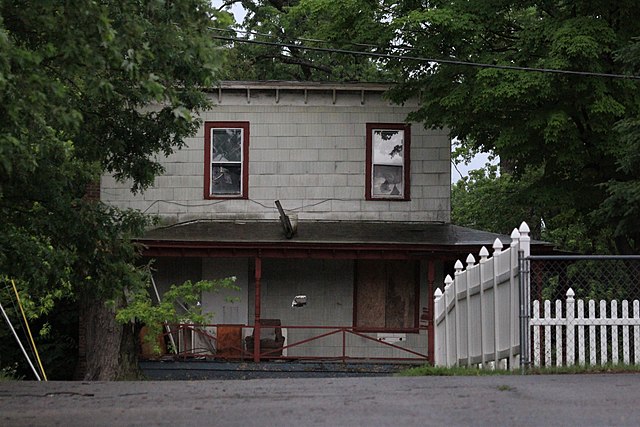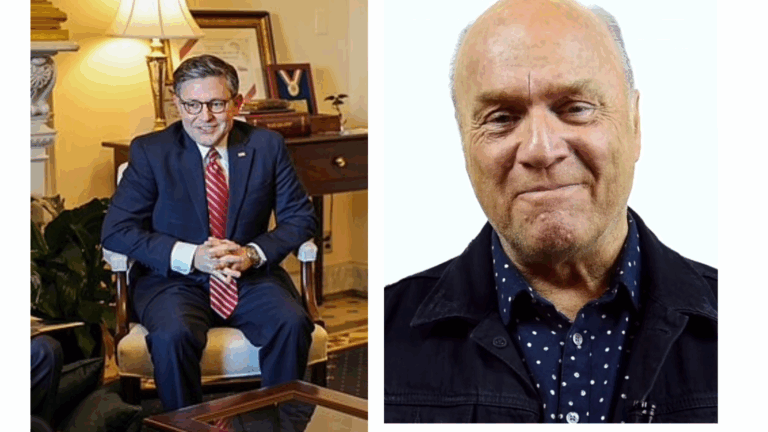
Driving around my once beautiful and prosperous state of New York has become equivalent to attending a wake: You see there’s a body lying in the casket—it looks kind of like it did when it was alive, but you know it’s really dead.
ORIGINALLY PUBLISHED AT THE EPOCH TIMES ON FEBRUARY 2, 2024:
We Don’t Want You Anymore: The Plight of Rural, Native-Born New Yorkers | The Epoch Times
Driving around my once beautiful and prosperous state of New York has become equivalent to attending a wake: You see there’s a body lying in the casket — it looks kind of like it did when it was alive, but you know it’s really dead.
One small Upstate New York town that epitomizes that feeling is Fulton, NY. Formerly known as “the city with a future,” it was once the home of prosperous companies like Nestle’s, Miller Brewery, Sealright packaging company, Birds Eye, Hunter Arms and backbone industries of yesteryear like paper plants and woolen mills. Today however, the city is a burnt-out shell of its former self.
But it was no fire that gutted the city, it was lack of decent jobs. One by one, and for various reasons, the companies left, leaving residents to compete for jobs at gas stations, Walmart, or McDonalds.
Fulton is located within Oswego County, which has recently seen a dramatic surge in homelessness (79% increase) even as it suffers from some of the worst food insecurity in the state. How does this manifest itself in an area known for its freezing temperatures and hard winters? It’s hard to say.
The director of a county Housing and Homeless coalition there admits many of their rural homeless are “hidden,” not even showing up in annual HUD required surveys. “Couch surfing,” is a term used to describe the homeless that are unaccounted for. It’s a population of usually young adults who are staying with whatever friends or family offer a couch to sleep on. These are the invisible people who don’t show up in a headcount conducted at shelters funded by the local Department of Social Services or other official organizations.
A coalition director was quoted as saying, “I think there are challenges for the rural community trying to end homelessness because it’s really hard to get a good scope of what the issue is.”
But we do know what the issue is. As Congresswoman Elise Stefanik has said, decades of Democratic leadership have made the state unlivable, even as it leads the nation in population loss. Cities like Syracuse, Rochester and Buffalo rank among the top 10 cities in the United States for highest rates of child poverty.
An rural New York pastor whose church provides hot meals for the needy told me: “We’re seeing such a surge in people who need food and clothing that it’s hard to keep track, and asking them to leave contact information might scare them away. You see, many people can’t afford to pay their mortgages or rent anymore; they’re just becoming lost in society,” he said.
I was curious to know if we were talking about new immigrants (i.e. ILLEGALS). The pastor said that about half of the people they were helping were new immigrants but the church “had no idea where they were coming from.”
The other half seemed to be native-born New Yorkers who were either a) renters who could no longer pay rent, or b) folks being forced to give up family homes because they could no longer afford mortgage payments or maintenance costs.
And you can see these homes not just in places like Fulton, but across the state. (Deserted New York properties have oddly turned into the stuff of macabre art — as photographers Bryan Sansivero and Nicholas Long have documented in their work.)
Abandoned properties are marked with a red and white “X,” to let first responders know they’re uninhabited and structurally unsafe. If you ask around, no one knows what happened to the people who lived there; it’s a story that’s repeated in every dying county from Buffalo to Albany, from the Adirondacks to the Catskills.
Known as zombie properties, most of these homes are abandoned when faced with foreclosure. New York’s Department of Financial Services tries to get mortgagees to maintain the properties, but that’s easier said than done.
Zombie houses often provide the perfect shelter for drug dealers, where users get caught in a cycle of binge-using illegal substances, thus the idea that they become “trapped” in the house.
I first learned of “trap houses” when selling my aunt’s property in a small northern New York town. She had passed away in her 90’s, leaving a beautifully maintained house on a quiet tree-lined street.
But as I tried to sell the house, I learned this was no quaint, small-town neighborhood. Neighbors told me trap houses infested the area, and the Drug Enforcement Agency (DEA) was monitoring surrounding properties with cameras. Large drug busts were common. The property was greatly devalued and sold at a loss. I know my poor aunt, confined to her house in later years and aided by visiting caregivers, never even knew of the horrors taking place just outside her door.
The out of control drug problem in Oswego County, including opioid overdose-related deaths, has worsened dramatically in recent years, as it has across the nation. (Most folks aren’t even aware that New Yorkers living in small cities and rural towns are more likely to die from an opioid overdose than people living in large cities.) But it’s important to remember that homelessness and poverty aren’t always linked to substance abuse. Sometimes these situations involve mental health issues; other times it’s simply a bad economy and a convergence of unlucky circumstances that drives people to the lowest points in their lives.
The powers that be act like the root causes of homelessness and poverty in rural New York are a big mystery. They aren’t. If you don’t have industry, you don’t have jobs. If you don’t have a job, you can’t maintain your home. For those in suburban and rural areas, a car is the single greatest necessity to get to work, groceries and healthcare; thus, car maintenance trumps house maintenance.
But instead of curbing liberal tax-and-spend policies that continue to hurt the economy, leaders cry with one consensus: “We need more affordable housing!” That’s right, if people can’t afford their homes, they’ll need to be stacked up in HUD funded government buildings where they can be tracked and monitored properly. (The application process speaks for itself.)
While the cost of housing continues to outpace wages even as the cost of living goes up, the middle class is being picked off in a sadistic, Whac-a-Mole kind of way. Those that could afford to have fled the state at record levels, while the poor who remain can put their names on a waiting list which randomly picks who to help using a lottery based system.
So what is New York doing to help stem the tide of fleeing residents? They’re saying “Don’t let the door hit you in the butt” – even as they bring in new immigrants and asylum seekers to replace the population they couldn’t take care of in the first place.
One city that’s done just that is Utica, NY. In it’s heyday, it churned out radio tubes from General Electric (GE) and portable power tools from Chicago Pneumatic.
In her book “City of Refugees: The Story of Three Newcomers Who Breathed Life into a Dying American Town,” author Susan Hartman wrote about Utica’s downturn explaining, “Now out of work and demoralized, residents turned against their city.”
For the book, Hartman interviews Utica native, Democrat pollster and globalist John Zogby, who recalls a bumper sticker from those hard times that read, “Last one out of Utica, please turn out the lights.”
(For a quick schooling on globalist views, see “John Zogby on First Globals” where he praises millennials for being “the least likely to say that American culture is superior to the cultures of the rest of the world” – a widespread foundational principle of globalism.)
Utica, the county seat of Oneida County, was ripe for reappropriation, and that’s exactly what it got. With the help of Non-governmental organizations (NGO’s) well known for fueling illegal immigration like Catholic Charities and Lutheran Immigration and Refugee Services, as well as an organization simply called, The Center — Utica became known as “The town that loves refugees.” The United Nations Refugee Agency did an extensive article in their 2005 magazine lauding the city for its “love affair” with refugees who supposedly “saved a dying city.”
And while the story goes that Utica welcomed refugees with open arms, it’s also clear that civil liberties activists used lawsuits — like the one against the Utica City School District – to get the compliance they wanted. (While the population of Utica is about 64,000, the school district struggles with a student body that speaks 42 different languages.)
The only criticism the U.N. article presents is about the locals who “Inevitably … complain about the refugees receiving massive cash handouts, free apartments and easy jobs — grumbles heard wherever refugees resettle around the world, but all untrue.”
But it is true; even more so since 2005. How else could refugees who came here with nothing have purchased “cheap properties” and “renovated entire neighborhoods?” How else could they establish restaurants, stores, salons, coffee shops, churches, mosques and temples, not just in Utica but throughout the state and beyond? It’s what a lot of New Yorkers have been wondering.
The concise answer comes from a website set up by immigrants for immigrants. It accurately reports: “The best part about the U.S.A. government is that they offer more opportunities to start their own business to immigrants with nothing compared to those born in the United States. Amazing, right?”
Amazing is right, and that refugee assistance is flush with money from public and private donors.
Under the U.S. Refugee Admissions Program, refugees are eligible for “assistance or support from private sponsors upon arrival in the United States. Each refugee approved for admission … is sponsored by one of ten non-profit resettlement agencies participating in the Reception and Placement Program under a cooperative agreement with the Department of State, or through the new private sponsorship program, Welcome Corps.” (President Biden’s new refugee aid program, “Welcome Corps,” was recently hailed as a great success.)
This law center website gives immigrants tips to find funding through “state governments or nonprofit/charitable organizations,” encouraging them to find grants that don’t have to be paid back.
The U.S. Department of Health and Human Services, Office of Refugee Resettlement, helps “newcomers achieve economic self-sufficiency” with cash assistance, matching grants, agricultural partnership programs to start their own farms, and individual development accounts and training in professional or skilled career fields.
Ironically, and in a move that looks more like bribery, even the Department of Homeland Security (DHS) is funding the migrant crisis, paying out millions to cities and charities willing to help.
Most recently in New York, Governor Kathy Hochul proposed spending more than $2 billion dollars in taxpayers’ money to assist migrants. (Even as the state has gutted it’s own tax base by driving out its wealthiest residents, it seems the poor suckers who remained behind are funding their own demise.)
Then there are remittances to consider. The World Economic Forum estimates that migrant workers around the world sent roughly $8 billion to their home countries in 2022. The top five recipients were India, Mexico, China, the Philippines and Egypt. Why shouldn’t we assume that the people we’re paying to train, who are getting cash assistance and grants, aren’t sending money home as well?
And while refugees, asylum seekers, illegals or migrants — whatever name you give them — pour into New York State by the thousands daily, we are told that the 30% child poverty rates in the state are due to “structural and systemic racism.” You can’t make this stuff up.
Oneida and Oswego counties joined 28 other counties in issuing emergency declarations and executive orders barring sheltering migrants. They were both sued by attorneys representing New York City, who accused them of being “xenophobic” — simply for trying to protect their own populace in the midst of an ongoing poverty and housing crisis.
For me this hits home. It’s gut-wrenching to see a once great people suffer the way they are today. These are the suburban and rural folks I was born and raised with. Farmers, machinists, factory workers and craftsmen. They were self-sustaining, independent people. Many of them were Christians whose goodwill was exploited.
The truth is we all come from immigrants, and regardless of what the globalists want me to think, the diversity of our melting pot is just one reason I believe America is superior to other cultures.
What’s happening now, however, feels more like forced displacement of native–born Americans. New immigrants should be wary and remember that when their views are no longer in alignment with the prevailing establishment, they too may become “lost in society” even as a new, more malleable population is brought in to replace them.





Ms Harris
Thank you for your writing about Native New Yorker.
in Epoch Times, it definately struck a chord with me as a native New Yorker.
I am in my mid sixties, practiced Architect in NY for over 30 years, travelled all over the State witnessing plenty of cities and towns like Fulton. I certainly know Utica. I am old enough to remember a different NY, and witnessed the decline with my own eyes.
My great grand parents immigrated from England and Scotland in 1915. They settled in a rural area north of Utica, great grandfather was a stone mason, my grandfather was a mechanic. They built businesses, ran a post office and general store, hauled ice and timber, and grew their own food. NY was the land of opportunity if you worked for it. It kind of was for me too, only now realizing the shackles on my profession, it could have been much better for my family. I know now.
I graduated college, moved back to NY with my wife, a native girl from Tenn.. We both worked hard, bought a small farm South of Rochester -where we lived for decades. One day we woke up -how could we ever afford to pay our taxes in retirement? Our house was paid but property taxes alone were $13K a year.
We had a modest home, but do not have lavish public pensions to keep paying that.
I came to be belief years ago, dealing with School Districts, and government projects, employee benefits, pensions, etc,….that NYS the way they were funding these entities was unsustainable.
We left NY in 2017 to East Tenn, built a home, and thank God every day for our decision. My architecture work is flourishing.
We have literally saved over $100K in taxes in 7 years.
We drove back to NY last year to visit friends. Driving around those days, felt like we drove into a depression. No new construction, boarded up businesses and houses.
Unless you get out of NY, and can see there is a better way of life…some NY people don’t know. It makes me sad, and angry what they have done to our beautiful State of New York.
Life is short, we did not see any other way but out.
I can relate very well to what you wrote about. One of my dear daughters’ just sold the homestead of her dreams.The assessment for taxes was raised X3 (!!!) and she and her family could not afford to live there. She has lived in rural upstate NY all of her life. Although my heart breaks knowing she will no longer be a few miles away, I’m also THANKFUL she will be starting a new chapter in her life that will give her family much more freedom to live minus the TAXES and political stronghold we have in NY. Tennessee is beautiful place and I look forward to joining her there one day….
Great article!
A precious clue to my questions.
Thank you for your courage to speak the truth!